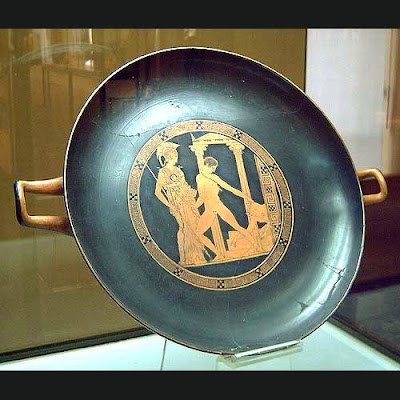Around 500 BC, well before the Greek tragedians put their work before Athens, Euphronios was running a pottery workshop in the city. Along with the painter Onesimos, he produced bowls, cups and other work that addressed some of the great scenes of Greek lore - the death of Sarpedon is renowned. Another work, now in the Louvre, is a large cup that on one side stages the encounter of Theseus with Amphitrite, the goddess wife of Poseidon.
On another piece that shows Theseus slaying the Minotaur, Athena stands by the hero:
Thanks to a thoughtful post on Something by Virtue of Nothing I now know that that encounter is told in a dithyramb by Bacchylides, found here. The poet vividly captures the moment when Theseus, sailing with Minos to Crete as one of the Athenian youth to be sacrificed to the Minotaur, objects to the Cretan king's wanton attempt to touch the face of an Athenian virgin.
The objection escalates to a competition of claim and counterclaim as Minos asserts his power by virtue of his descent from Zeus, and challenges Theseus to prove to be the son of Poseidon. It's a great story, a contest of a sky god's world versus that of the sea god, narrated with economy -- Bacchylides doesn't go for completeness -- he extracts certain bits of it for his song. In addition to the version here, there's another translation on Perseus, here.
The relevance for us is that these works -- poems and pots -- offer a suggestive witness to the figure of Theseus. In this image from the Louvre, the workshop of Euphronios and Onesimos render the scene after Theseus dives into the sea to retrieve a ring thrown by Minos. The king is clearly expecting Theseus to drown. Instead he is borne by dolphins to Amphitrite, who gives him a splendid purple cloak and a wreath. Theseus reappears at the stern of the ship, which has been sailing on, "unwetted."
Between Theseus (left) and Amphitrite (right), the workshop depicted Athena:
On another piece that shows Theseus slaying the Minotaur, Athena stands by the hero:
The human hero of Athens who overcame Minos and the Minotaur is deeply associated with Athena. On the other side of the first image above, the workshop portrayed several of Theseus's famed encounters with monsters on the road from Troezen to Athens -- his first heroic acts, performed before he'd even met his human father, Aegeus. A description notes:
On the outside of the bowl, Onesimos has completed the cycle of Theseus by representing four of the hero's deeds on the road from Troezen to Athens. They appear above a meander and are separated by trees from which the hero's attributes (himation and sword) are hanging. Beside a bronze pool, Theseus is picking up the bandit Sciron in order to throw him into the sea. His head tipped back, his eyes bulging, and hair shaggy, Sciron is trying to cling on to the rock to avoid falling. Next to this scene, Theseus is seizing Procrustes by the hair and preparing to kill him with his sword. On the other side, Theseus is fighting with Kerkyon, whose look of fear is accentuated by the frontal positioning of his face. In Theseus's final exploit, he manages to hobble the bull of Marathon.
Theseus is not purely a hero of force, of power. He has a special link with the goddess of wisdom -- as did Odysseus.
It's worth keeping this in mind as we wrestle with the profoundly unwise act of Theseus, who calls on his divine father to destroy his son, based upon a lie from the daughter of Minos. And it's with this story in mind that we want to look at what befalls Hippolytus as he is about to set out from Troezen, to begin his own life outside the city of Pittheus. In a sense, he's at the same point in his life as Theseus was when he set out and met the monsters. We should consider all this as we ponder the wave, the bull, and the fulfillment of Theseus's prayer -- before we too quickly find him a fool, or a dupe of callous divine powers.




No comments:
Post a Comment